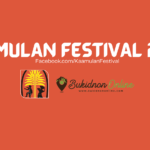Live blogging: Kaamulan Ethnic Street Dancing 2008
Friday, 07 March 2008
Taking notes and writing them down in real time plus taking photos from a strategic point along Fortich Street, Malaybalay City, Bukidnon – the very same highway where the street dancing will take place! The fun starts on March 8, 2008!
5:30 am Pamuhat
Tribal leaders led the pamuhat at the Pine Hills – Sumpong area. They brought with them live animals for sacrifice. Garbed in authentic native customes, the leaders prayed to Mambabaya for guidance, continuous harvest, peace and harmony. All the seven Bukidnon hill tribes were represented by tribal leaders.
7 am Start of Kaamulan Ethnic Street Dancing Competition 2008!
 Contingent number 1 – from the Municipality of Maramag, BukidnonThe group representing Maramag for the Kaamulan Ethnic Street Dancing Competition 2008 wore costumes that were a colorful mix of red and yellow with hints of white. The group was led by bow and arrow-bearing men who depicted their everyday lives as hunters. The group also brought with them a large streamer that bore the sign “Ar Ramag” – Maramag’s native name. The women street dancers wore skirts, accessories on their shins and headdresses with hints of black, red, yellow and white. The women street dancers also brought with them dried grass and used them during their performance.
Contingent number 1 – from the Municipality of Maramag, BukidnonThe group representing Maramag for the Kaamulan Ethnic Street Dancing Competition 2008 wore costumes that were a colorful mix of red and yellow with hints of white. The group was led by bow and arrow-bearing men who depicted their everyday lives as hunters. The group also brought with them a large streamer that bore the sign “Ar Ramag” – Maramag’s native name. The women street dancers wore skirts, accessories on their shins and headdresses with hints of black, red, yellow and white. The women street dancers also brought with them dried grass and used them during their performance.
As for musical instruments, the group used drums which had animal skin surfaces and short bamboo poles. Maramag’s float showcased the town’s abundant flora and fauna – huge sunflowers adorned the float. Sunflowers are aplenty in the said town.
Contingent number 2 – from the Municipality of Manolo Fortich, Bukidnon
The contingent from Manolo Fortich, Bukidnon wore costumes that were a rich color of blue. Leading the pack were young children who had ready smiles on their faces. The women dancers, who brought with them large handkerchiefs of sorts (tubaos), swayed to the music and showcased finesse and delicate footwork. The young male dancers had small, red headdresses.
Contingent number 3 – from the City of Valencia, Bukidnon
The local government officials of Valencia City, Bukidnon led the group. City Mayor Leandro Catarata and the members of the City Council as well as the City Vice Mayor all lined up, smiled and waved at the spectators. City Councilor Atty. Oliver Owen “Babba” Garcia as well as his mother, former Bukidnon Girl Scouts Council President now Ways and Means Committee Chairperson Lolita Garcia were also there.
The dancers also wore blue native costumes. The male dancers, who also had red head covers, looked fierce – as if readying themselves for war. The other male dancers also brought with them kulintangs and other native musical instruments.
Valencia City’s float was very colorful. It bore the colors of Kaamulan – red, black, yellow, blue and white. Several instrumentalists pounded on short bamboo poles and walked side by side the float. Brooms also adorned the float.
Contingent number 4 – from the Municipality of Libona, Bukidnon
The contingent from Libona town wore deep, rich red costumes. The ladies wore the famous tribal headdresses while the men also wore red head covers. Some dancers – male and female pairs – brought banigs with them (woven mats) and depicted everyday lives as members of the tribe.
The float was a sight to behold! It showcased the crops in Libona – corn, bananas, pineapples, tomatoes and carrots. The vegetables were delicately placed – the result was one very creative float!
Contingent number 5 – from the Municipality of Don Carlos, Bukidnon
The pack from Don Carlos, Bukidnon was led by a tribal member who brought a bamboo pole that had dried boar skin as main decoration. The contingent also brought with them a lot of large, colorfully printed cloths – which looked as if these were curtains that “introduced” or “presented” their contingent to the spectators. A young child warrior, who brought a shield and a spear danced around the streets and engaged the crowds. A large wooden cart then followed – the cart held a small tribal family – the father, mother and child who all wore authentic native garb. Around the family sat some chickens and roosters – they looked as if they depicted everyday life at the farm for a native Bukidnon family.
All of the dancers also wore wigs that made them look as if they had long, braided hair. Historically, natives of Don Carlos reportedly sported this type of hairstyle. The male dancers also had purplish lips and held spears and shields.
Contingent number 6 – from the City of Malaybalay, Bukidnon
The Kaamulan Ethnic Street Dancing Competition 2008 contingent from Malaybalay City, Bukidnon was led by males who brought poles that had colorful ornaments. The poles looked as if they were umbrellas with intricate details of red, yellow, white and black. There were also poles at the tail end of the pack.
The male dancers, meanwhile, wore black pants, red-and-black striped tops and red head covers. The females wore beautiful headdresses and flowy, wrap around skirts. They also had white and red cloths and used these in their presentation.
Malaybalay City’s float was very much attention-grabbing. A huge snake’s head adorned the front of the float. Around the snake’s head were lots of flora and fauna (anthuriums, sunflowers, bamboo shoots et al) – and it appeared as if the snake appeared from the forest.
Contingent number 7 – from the Municipality of Sumilao, Bukidnon
The female dancers from Sumilao, Bukidnon were dainty and danced gracefully. They also wore colorful headdresses and red costumes that had hints of white and black. There were also female dancers at the tail end of the pack who had painted bilaos on their backs and who also held large leaves. The group depicted how it is to plant and harvest.
Sumilao’s float was also very interesting. There were mini-waterfalls at both front and back. It was pretty obvious that so much attention was accorded on the making of the float as every detail is intricate and carefully placed. The float had a lot of flowers, too.
Contingent number 8 – from the Municipality of Lantapan, Bukidnon
Lantapan’s entry to the Kaamulan Ethnic Street Dancing Competition 2008 was led by a pack of small, very young children who were all dressed up in native garbs. While a few of them did bring spears, shields and poles, most just pranced around and engaged the crowd.
The female adult dancers wore flowy costumes that were largely red but with black and white details. The women had headdresses and large beaded accessories around the necks, on their ears, ankles and wrists. The males brought along with them spears and shields.
Lantapan’s float was by far the most applauded. Some local government officials were seated atop the float. The float was dressed up with a lot of flowers like calla lilies and anthuriums, weaves, banig and even vegetables like cabbages, tomatoes, carrots and peppers. The float was undoubtedly very impressive!
Contingent number 9 – from the Municipality of Baungon, Bukidnon
The contingent which represented Baungon may have been last to perform but they still gave it their best – thus, earning the crowd’s cheer and applause. Baungon’s float depicted the rich forests and fertile soil found in their town. Instrumentalists were also aboard the float – along with local leaders. The dancers’ costumes were a mix of red, black, yellow and white – the males had red head covers. The female dancers also wore headdresses and whipped white and red cloths as they danced.


![[UPDATED] Kaamulan Festival 2023 Schedule of Activities Kaamulan-2023-FB-Cover](https://bukidnononline.com/wp-content/uploads/2023/01/Kaamulan-2023-FB-Cover.png)

